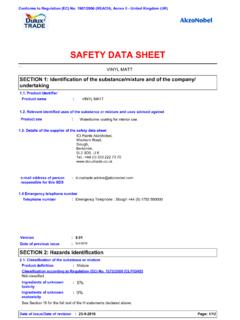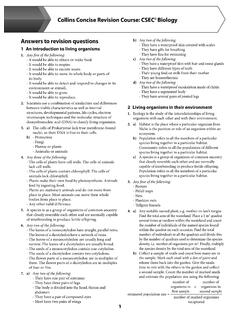Transcription of Chapter 2 Composting - USDA
1 (210-VI-NEH, February 2000)United StatesDepartment ofAgricultureNaturalResourcesConservatio nServicePart 637 Environmental EngineeringNational Engineering HandbookChapter 2 CompostingPart 637 National Engineering HandbookCompostingChapter 2(210-VI-NEH, February 2000)Issued February 2000 The United States Department of Agriculture ( usda ) prohibits discrimina-tion in all its programs and activities on the basis of race, color, nationalorigin, gender, religion, age, disability, political beliefs, sexual orientation,and marital or family status. (Not all prohibited bases apply to all pro-grams.) Persons with disabilities who require alternative means for commu-nication of program information (Braille, large print, audiotape, etc.)
2 Shouldcontact usda s TARGET Center at (202) 720-2600 (voice and TDD).To file a complaint, write usda , Director, Office of Civil Rights, Room326W, Whitten Building, 14th and Independence Avenue, SW, Washington,DC 20250-9410 or call (202)720-5964 (voice or TDD). usda is an equalemployment opportunity provider and i(210-VI-NEH, February 2000)Part 637 National Engineering HandbookCompostingChapter 2 AcknowledgmentsChapter 2, Composting , was prepared by Robert E. Graves, professor,Agricultural and Biological Engineering Department, The PennsylvaniaState University, and Gwendolyn M. Hattemer, engineering project asso-ciate, Agricultural and Biological Engineering Department, The Pennsylva-nia State University. Donald Stettler, environmental engineer, NaturalResources Conservation Service, National Water and Climate Center, Port-land, Oregon, coordinated the project.
3 This project was originally conceivedby James N. Krider, national environmental engineer, NRCS, Washington,DC (retired) working with Dana Chapman of The Pennsylvania StateUniversity and NRCS (retired).The major NRCS participates in the review of this document from its incep-tion were Barry Kitzner, national enviornmental engineer, Washington,DC, David C. Moffitt, water quality specialist, Fort Worth, Texas; Payne (retired), and Frank Geter (retired).The final edit, graphic production, and publication formatting were pro-vided by Mary R. Mattinson, editor; Wendy Pierce, illustrator; and SuziSelf, editorial assistant, NRCS National Produdction Services, Fort Worth, 637 National Engineering HandbookCompostingChapter 22 ii(210-VI-NEH, February 2000)2 iii(210-VI-NEH, February 2000)Part 637 National Engineering HandbookCompostingChapter 2 Chapter 2 1(a) Definition of Composting .
4 2 1(b) Composting in the United States .. 2 1(c) General procedure .. 2 of composting2 2(a) General background .. 2 2(b) Composting process .. 2 2(c) Microbiology .. 2 4(d) Chemical transformations .. 2 of compost mixtures2 11(a) Components of compost mix .. 2 11(b) Typical raw material .. 2 12(c) Determination of the compost recipe .. 2 and parameter adjustment2 17(a) Temperature .. 2 17(b) Odor management .. 2 18(c) Moisture .. 2 18(d) Oxygen and carbon dioxide .. 2 19(e) Monitoring equipment .. 2 generation2 , inoculums, starters2 Health risks of a Composting operation2 24(a) Bioaerosols .. 2 requirements2 25 Part 637 National Engineering HandbookCompostingChapter 22 iv(210-VI-NEH, February 2000) Analysis of raw materials and compost2 28(a) Determining moisture content.
5 2 29(b) Bulk density .. 2 30(c) pH and soluble salts .. 2 30(d) Particle size distribution .. 2 31(e) Organic matter content .. 2 31(f) Substrate degradability .. 2 31(g) Compost quality .. 2 31(h) Determination of compost stability .. 2 methods2 36(a) Passive Composting piles .. 2 36(b) Windrow .. 2 37(c) Passively aerated windrows .. 2 37(d) Aerated static pile .. 2 38(e) In-vessel systems .. 2 39(f) Comparison of Composting methods .. 2 40(g) Controlled microbial Composting .. 2 animal composting2 44(a) General .. 2 44(b) Dead poultry and small animal Composting .. 2 46(c) Dead swine and large animal Composting .. 2 costs2 50(a) Availability and price of raw material .. 2 50(b) Quantity and price of land available for the Composting operation.
6 2 50(c) Estimated costs of operation/production .. 2 50(d) Pre-startup cost .. 2 51(e) Material handling .. 2 51(f) Monitoring .. 2 51(g) Operations after completion of Composting .. 2 end use2 52(a) Land application .. 2 52(b) Marketing considerations .. 2 54 Glossary2 592 v(210-VI-NEH, February 2000)Part 637 National Engineering HandbookCompostingChapter 2 AppendixesAppendix 2A Common Raw Materials for Farm Composting .. 2A 1 Appendix 2B Testing Material on the Farm .. 2B 1 TablesTable 2 1 Dewar self-heating method for determining2 34compost maturityTable 2 2 Stability of compost based on carbon dioxide2 34respired during incubationTable 2 3 Volatile organic acids as an indicator of compost2 35instabilityTable 2 4 Phytotoxicity as an indicator of compost stability2 35 Table 2 5 Mortality rates and design carcass weights for2 47determining the size of a dead swine Composting facilityTable 2 6 Mix for Composting dead swine with sawdust2 48 Table 2 7 Mix for Composting dead swine with broiler litter2 48using sawdust/straw as a carbon source and bulkingagentFiguresFigure 2 1 Compost temperature ranges2 2 Figure 2 2 Bacteria2 4 Figure 2 3 Fungi2 5 Figure 2 4 Actinomycetes2 5 Figure 2 5
7 Higher organisms2 5 Figure 2 6 Passive compost pile2 36 Figure 2 7 Windrow method2 37 Figure 2 8 Passive aerated windrow2 38 Part 637 National Engineering HandbookCompostingChapter 22 vi(210-VI-NEH, February 2000)Figure 2 9 Aerated static pile2 38 Figure 2 10 Bin2 39 Figure 2 11 Rectangular agitated bed system2 39 Figure 2 12In-vessel silo2 39 Figure 2 13 Rotating tube composter2 40 Figure 2 14 Dead bird composter2 45 Figure 2 15 Dead bird bin Composting schematic2 45 Examples Example 2 1 Determining the proportion of materials needed to2 14develop a mix based on the C:N ratioExample 2 2 Determining the size of a dead swine composting2 49facility2 1(210-VI-NEH, February 2000)Part 637 National Engineering HandbookCompostingChapter 2 Chapter Introduction(a) Definition of compostingComposting is the controlled aerobic biological de-composition of organic matter into a stable, humus-like product called compost.
8 It is essentially the sameprocess as natural decomposition except that it isenhanced and accelerated by mixing organic wastewith other ingredients to optimize microbial potential benefits of Composting manure andother organic wastes are improved manure handling;reduced odor, fly, and other vector problems; andreduced weed seeds and pathogens. Land appliedcompost improves soil fertility, tilth, and water hold-ing capacity. It is also free of offensive odors and canbe stored for extended periods. These qualities make itsuitable for use on the farm or for is easily adapted to agricultural opera-tions because farms generally produce suitableamounts and types of waste for Composting , haveadequate land, will benefit from the application ofcompost to the soil, and have the necessary equipmentalready available.
9 (b) Composting in the UnitedStatesComposting is more prevalent in the United States inresponse to concerns about agricultural pollution andthe encroachment of the urban population in ruralareas. The availability of cost-sharing to fundcomposting facilities, particularly in some criticalwatersheds, has also driven the growth of Natural Resources Conservation Service helpsfarmers to design Composting facilities as a part of awaste management system. Composting is used as atreatment component to convert manure and otherorganic material into a more environmentally is an alternative to more commonly usedmethods of managing manure and other organicwastes, such as poultry or livestock mortalities andcrop residue. It provides a means of developing anorganic source of fertilizer or soil conditioner.
10 Be-cause Composting is suited to a wide range of materi-als, it is possible for a Composting operation to workin cooperation with other farms, municipalities, andindustry to compost their organic wastes, such asmanure from horse race tracks, food processingwastes, or yard trimmings.(c) General procedureThe principal elements in planning a compost facilityinclude performing site investigations and developingthe recipe design, facility design, waste utilizationplan, and an operation and maintenance plan. Becausecomposting is a relatively fexible process, it is neces-sary to decide among alternative methods, locations,and materials. The decision depends on the manage-ment and economic aspects of the farm as well as onthe physical limitations of the site.
















